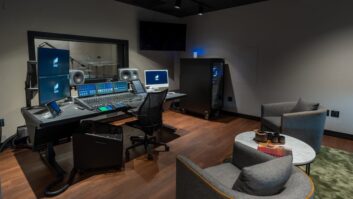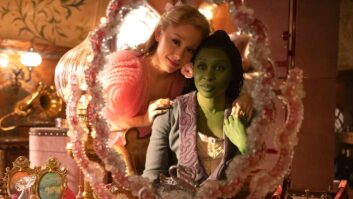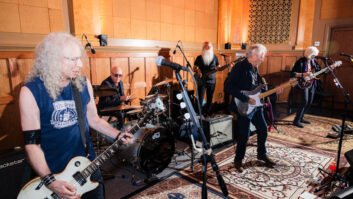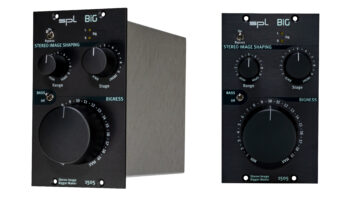Since its release, Bradley Cooper’s Golden Globe- and Grammy-nominated film A Star Is Born has been moving audiences with his and Lady Gaga’s musical performances. The two sing original rockers and ballads, backed mostly by Lukas Nelson and his band, Promise of the Real, all performed…live…right? Well, yes, and no.
The film, similar to its previous renditions, tells the story of a huge, but beginning to fall, country rocker, Jackson Maine (Cooper), who discovers a new talent, Ally (Gaga), whose career he helps launch as his alcohol-fueled failure deepens. Interspersed in the dramatic story are skillfully shot and recorded concert sequences that were filmed at venues such as The Greek Theater, Coachella Festival, Stagecoach Festival, The Shrine Auditorium, The Forum and even England’s Glastonbury Festival.
Films that include musical performances are not easy to shoot or mix, and nothing takes the audience out of the experience more than an abrupt shift to an obviously pre-recorded song, the actors clearly miming along. From the earliest production meetings, it was clear that Gaga in particular would have none of that.
“We had a lot of meetings in pre-production,” notes music editor Jason Ruder, “trying to figure out what road we were going to take with the music. But even in early talks, Gaga knew she wanted all of the vocals to be live—she was adamant about it. And Bradley loved the idea.”
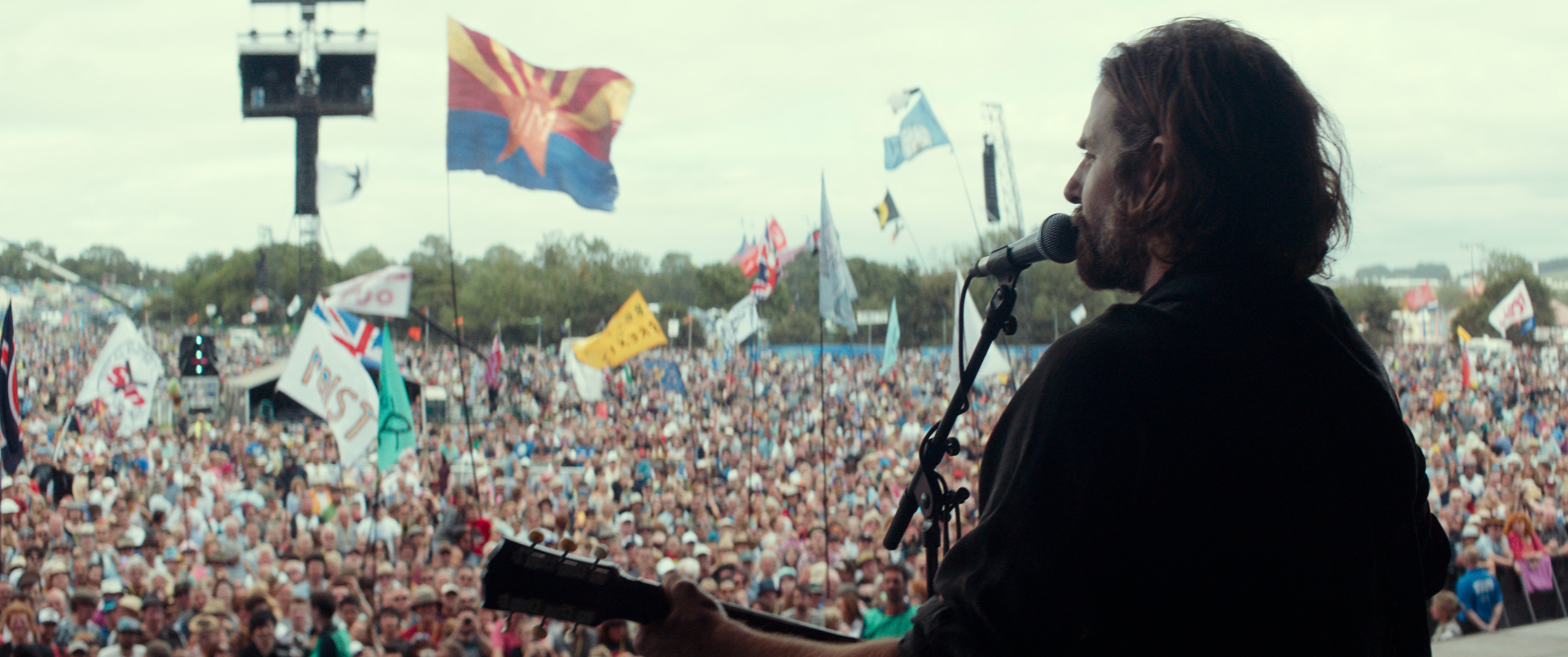
The challenge, then, was how to pull it off with a level of authenticity that never reveals itself to the audience. An expert team, including Ruder, production sound mixer Steven Morrow and music mixer Nick Baxter—all veterans of another hit musical, La La Land—came together to develop a system, drawing on their experience from that film. “The advantage here,” says Morrow, “is that they’re portraying rock stars—they will be seen on camera singing into [SM58] microphones.” On La-La Land, it was all hidden wireless.
While Gaga initially hoped to have vocals and band both perform live, there are risks to that approach when doing so for camera. “Warner Bros and myself were a little nervous about that idea,” Morrow recalls. “No matter how great a musician is, they’re going to play at different tempos every day and take to take. It just won’t cut together well.”
Vocals, they knew, would need to be recorded cleanly to allow them to be able to placed effectively into the final mix. Morrow suggested pre-recording Cooper, Nelson and band and playing back the pre-records of the instrumentation in earwigs, allowing the band to mime to their own recording, while killing the guitar amps out loud, deadening the drums as much as possible and recording Cooper and/or Gaga singing live as they listen to the playback in their ComTech in-ear monitors.
Key to the success of this setup was the use of impulse response (IR) measurement of each venue in which the cast was filmed and recorded. “Gaga was especially concerned about reverbs and ambience and environments,” Ruder says. So he enlisted Baxter, who had specific expertise in IR work, to set up the system.
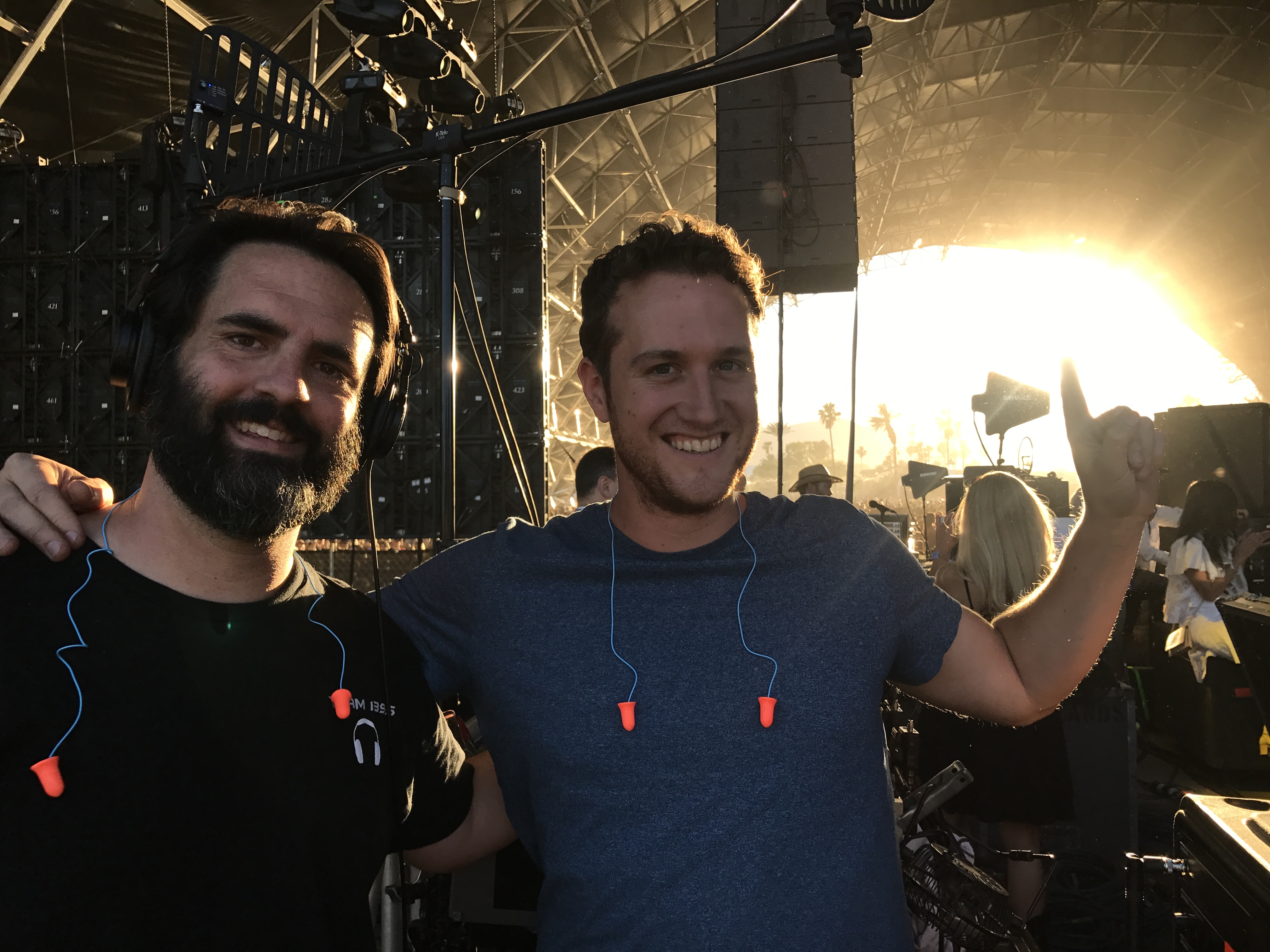
Baxter utilized Audio Ease Altiverb 7 convolution reverb plug-in to both do the measurement and create an appropriate reverb for each venue.
“It’s an impulse response reverb engine,” he explains. “It starts with a tone sweep—a sine wave that sweeps up from 20 Hz to 20 kHz, through the whole frequency spectrum. And you blast that out through speakers in whatever environment you’re in and record it back.”
The sweep was recorded using a favorite instrument of Morrow’s—his DPA 5100 surround microphone set at center stage, aiming out into the venue. “You’re with the band for so many of those shots, so we wanted to make sure we had an image of what the venue sounded like to them, onstage, instead of out in the audience,” Morrow says. “So we had mics up onstage to capture the impulse response as it sounds up there, as well. And you can switch between the two, as the picture edit requires.”
Though Ruder broached the subject with the assistant directors in prep, it took some doing to convince them and the studio that the 5 or 10 minutes of quiet time at locations was imperative to create the effect Gaga and Cooper wanted. “It became kind of a joke,” laughs Baxter. “It’s really loud. We’d clear the set and blast this ominous alien noise.”
Before fully committing to the process, a test was set up on a stage at Warner Bros in which a song was shot and recorded twice: once with the band and singers all miked and performing live (and using Baxter’s IR system to capture the profile of the soundstage), and then one in which the band quietly mimed to playback of a pre-record while Cooper/Gaga sang live to tape. Ruder and Baxter then took the two recordings to 5.1 mix rooms on the lot and created mixes of the two performances, which were then played back to Cooper and team. Says Ruder, “Everybody went, ‘Okay, this is really cool. We gotta make sure we catch everything we need on set, but it’s going to work.”
Tracking the Pre-Records
The songs Gaga, Cooper and the band are seen performing in the film were written by various combinations of writers, including them and Nelson, Jason Isbell, Mark Ronson, Nick Monson and Paul “DJ WS” Blair. The recordings were made at a few studios (including some early tracking produced by Dave Cobb in Nashville), with a good deal done at The Village West’s Studio D, Eastwest Studios, Woodrow Wilson Studios (Gaga’s recording facility) and elsewhere.
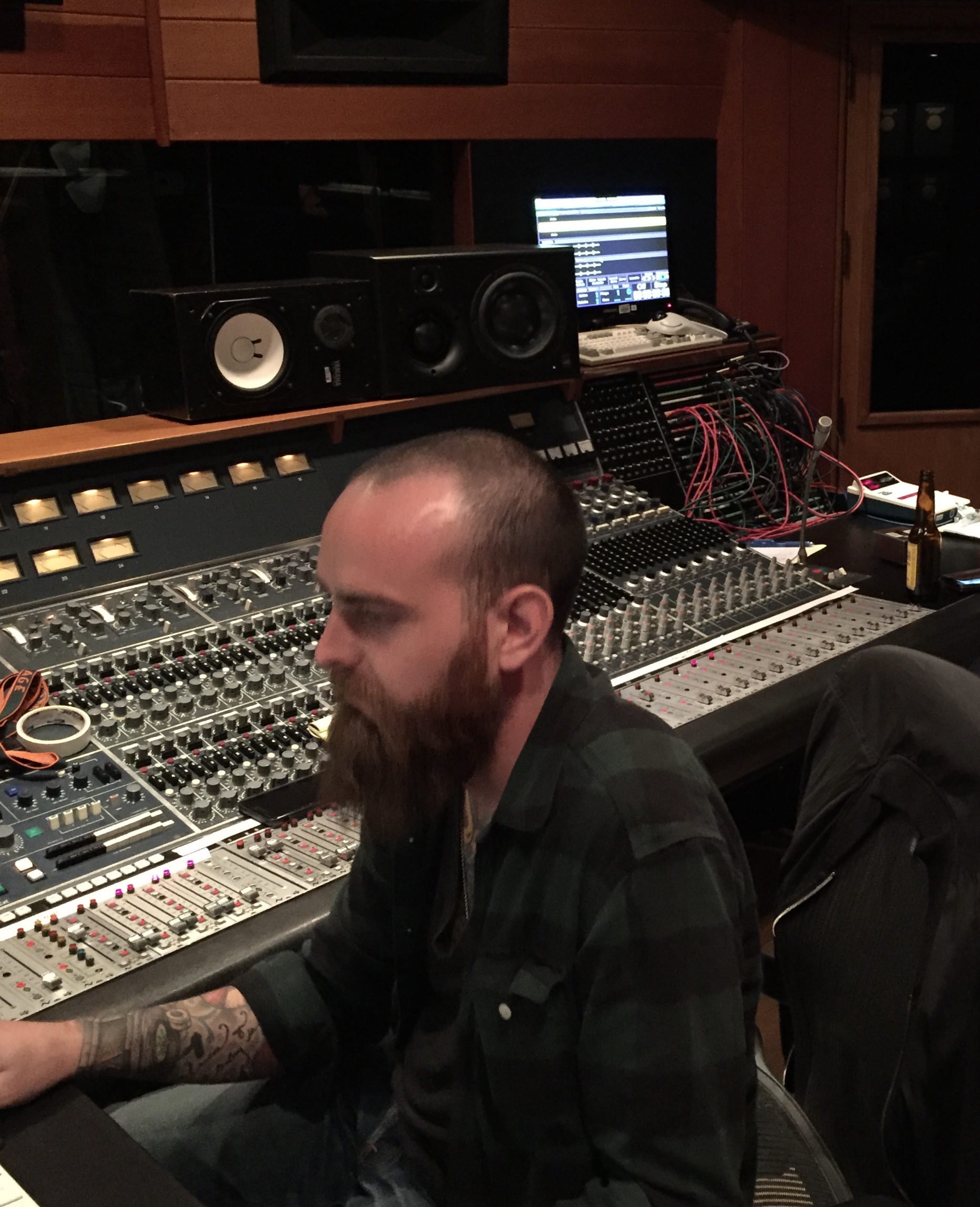
While Gaga, Cooper and Nelson produced many of the recordings, nearly all were engineered (and several co-produced, including the Grammy-nominated “Shallow”) by Benjamin Rice. Rice had been a staff engineer at Record Plant in 2013, during the recording of Gaga’s ARTPOP, and was tapped by Rose Mann-Cherney one day, to fill in as engineer. “At the end of the day,” he remembers, “Gaga walked out of the studio and gave me a high five and said, ‘Well, I’ll see you in the morning—just me and you.’” The two have worked together ever since. [Rice even appears in the film, in scenes actually shot at Village Studio D, showing Ally and Jack doing their first recordings.]
The approach to the recordings was to be live, as a band, creating what the musicians would sound like if they were performing live in concert. “I was trying to make the band sound ‘live’ in the studio, keeping in mind that this needed to be very raw and natural, just gritty and cool sounding. And that’s just naturally their wheelhouse—they’re used to being able to perform a record and not having to worry about dissecting it with overdubs. He and those guys are just so incredibly talented as musicians.”
Key for each track, he notes, was being certain all understood how that song fit into the story and character arcs. “That was always at the forefront of our minds,” he explains, “’What is the sound supposed to be?’ And we would try approaches with different instrumentation that may work, it may not. And just circle into, ‘This is the sound for Jackson,’ or ‘This is the sound for Ally.’”
Cooper and Nelson’s “Out of Time,” for instance, is heard as Ally finally gives in to Jack’s wishes to have her join him for the first time at one of his concerts, eventually coming onstage.
“Bradley wanted it wooing her to the stage, pulling her closer and closer to him,” Rice explains. “He said, ‘I want a long song, but have it just start to explode, more and more, culminating in her finally getting close to him onstage. He’s trying to get her to come see him again. So I want the drums building and the bass to build, and I want a solo that builds.’ He was very specific. I’ve never worked with a director who was so hands-on. He really did his homework and knew precisely what his vision was. And there was nothing better than to hear him say, ‘Ben, this is the Jackson sound. This is what I’m talking about.’”
Tracking on Location
The process on set would begin the night before filming, with delivery of stems (and, in some instances, whole Pro Tools sessions) from Rice to Jason Ruder, who would then prep the material for the following day’s work. The stems were fairly wide, offering full control for monitor playback. Rice also provided a rough vocal comp from the studio, Ruder notes, “just so everyone would have something to rehearse to.”
Ruder would hand off the stems to Baxter who was brought to set to run Pro Tools playback, music edit, and collaborate on the live recordings. “The content was changing so fast that I had a hard time keeping up with all the versions,” Ruder explains. “So we brought in Nick to run Pro Tools on set, to play back to Steve [Morrow], which made things a little easier.” Baxter would then prepare monitor mixes for Morrow (sent to him via CAT5 cable, over a Dante network), who would then send them through the monitor playback system.
The mix would sometimes first be played through wedge monitors, allowing the band to rehearse more easily to it, but then, for camera, strictly through ComTech earwig monitors. Cooper sometimes would still receive his mix through a wedge, at low level, which was easier for him to sing to, though, for his earwig mix, he would hear his pre-recorded guitar part louder, to facilitate matching his on-camera performance better to the track. Morrow would also feed the players the live vocals in their earpieces.
In some venues, such as the first scenes, shot at Coachella, Gaga’s own monitor mixer was brought along to help guide the team. “Bradley’s an actor, so he’s used to the way production sound works,” Ruder explains. “But it took a little getting used to for her.” He also noted that she was more accustomed to singing at concert volume, rather than what a sound team is used on a film set. Skilled and intuitive, she quickly adapted.
When the time came for a take for camera, the guitar/bass amps’ speaker output was killed (but available via direct input for recording, if needed), and drums were muted, Morrow notes, often by placing rehearsal pads on top, to allow the drummer to be seen realistically hitting the kit, but producing little sound. Says Ruder, “It was all about getting a clean vocal track.” The team was completely prepared for recording at every venue, with every instrument miked as if it was a live concert and fed to Morrow.
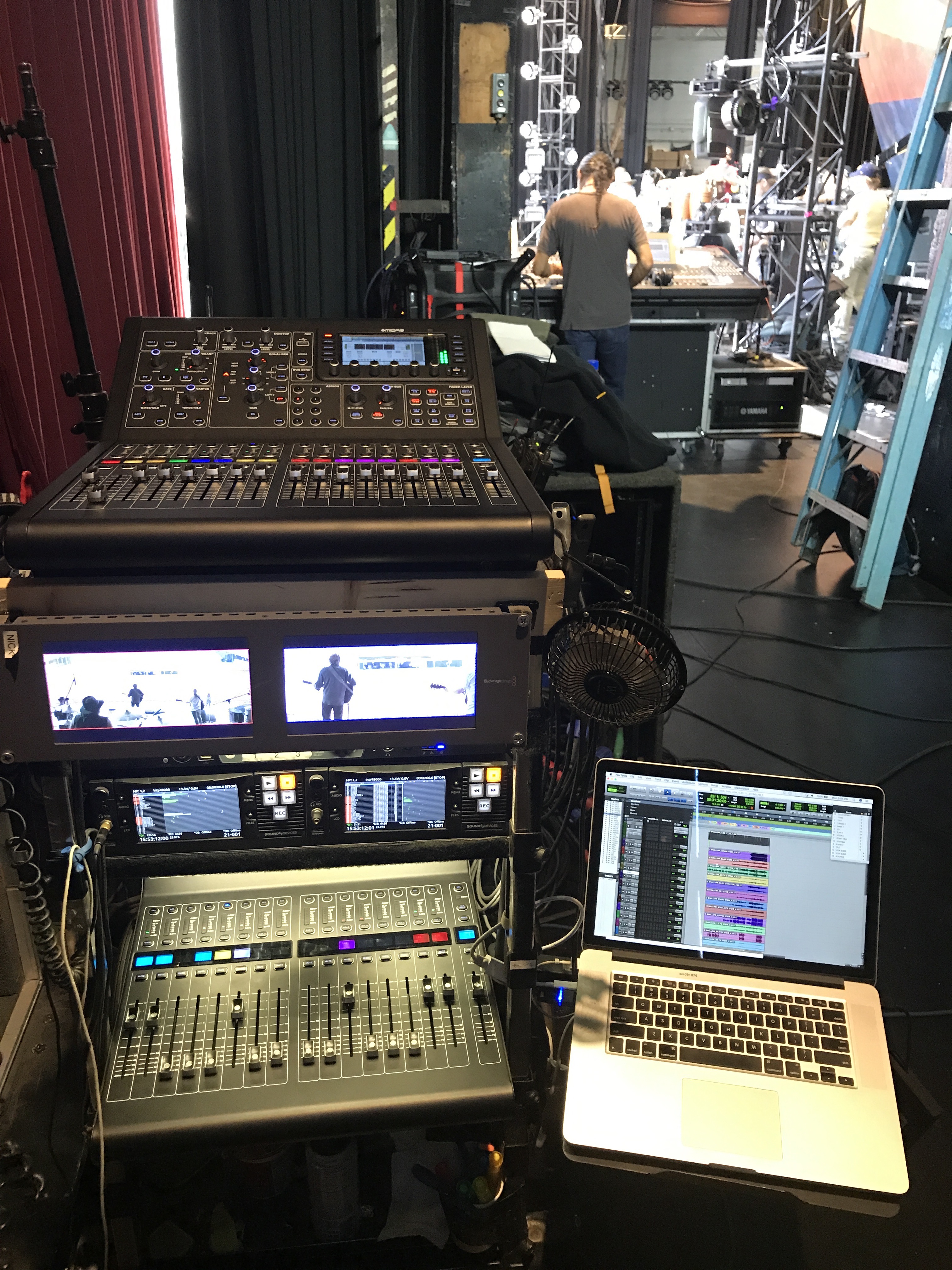
Morrow’s rig consisted of a pair of Midas M32R mixing consoles, each with 32 inputs, allowing up to 64 tracks to be recorded. The tracks were fed over Dante to two Sound Devices 970 recorders (one for master, one for backup). Baxter would take a duplicate feed over the network from Morrow back to his Pro Tools rig to also record the vocals.
“Steve’s recording would go into the sound roll to be used in post,” he explains. “But this way it would save a step during mixing because those new vocals and live instruments are already synced to the Pro Tools session, because they’re recorded to those tracks which are being played back. Plus, I could do comps on the fly if I got notes from Gaga or Bradley on takes they liked, etc. Everything’s already locked and labeled.
“This way we could also be ready in Pro Tools for any scenario,” he continues. “That meant rearrangements of songs, moving sections around, changing tempo, cutting out sections. Or if she wanted to go live with an instrument, we wanted to make sure we weren’t impeding the creativity at all. It was a work in progress throughout, always striving to improve the flow of the track as th scene came together.”
Different versions of individual songs were also sometimes required, most notably for the film’s moving closing number, “I’ll Never Love Again,” which follows Jack’s death.
“That was a really rough day for her,” Rice says of the scene, shot at The Shrine Auditorium. “Gaga had lost a very dear friend, who had worked on her team for years and who actually died that day from cancer.” The artist, unsure of what tempo or key would best fit the scene and how she would choose to deliver the song on camera in the moment, asked Ruder to prepare seven versions of the master—in four tempos and three keys—to allow playback at whatever was required.
The effect—and the team’s ability to instantly provide as needed—produced the most poignant moment of the film. “If that had been a pre-recorded vocal, instead of sung live, there’s no way it would have worked,” Rice states. “You hear her cry, be very emotional and tender. You go on the journey with her. If you were there and weren’t affected by it, something’s wrong.”
Interestingly, that vocal—like all in the film—was performed for an audience of extras who not only could not hear the music, but often could not hear Gaga’s or Cooper’s vocals. Gaga would invite 500 to 1,000 of her “Little Monsters” from her fan base to participate as extras, but, with the debut of new music on set a year prior to the film’s release, it was quickly decided that playback of the backing track and live vocals through the P.A. would not be allowed. No music or vocals were ever heard during filming, save at rehearsals or between-take fun, outside of the earwigs.
Though her fans could be trusted to produce an excited response anyway, she, Cooper or a production assistant would explain the context of the song and then guide them through their reactions. Morrow also recorded the audience reactions, again using his surround microphone, to be used later in the mix.
Post-Production
Immediately after a big concert scene shoot, Ruder would dash back to his 5.1 suite at Warner Bros and spend a day putting together a rough mix for Cooper, who, more often than not, would respond with an, “Okay, wow. This is cool.”
As soon as possible, Ruder and Baxter would begin editing and mixing with the full performance rough cut assembled by picture editor Jay Cassidy, who would use Morrow’s rough mixes and the linear timecode from the set to put together matching audio, which Ruder could then use as a base for his own assembly.
“Jay had an amazing picture assistant” Ruder says. “I had him put in every take number for every shot, so when we got into heavier editing, I could see where every shot came from and from which take to pull the audio from. I would always start with that—what’s on screen—and not just comp for no reason.”
Vocal edits also had to be accompanied by edits of crowd recordings from those same takes. “We did six or eight takes of everything, and there was bleed into the vocal mics, so everything had to match,” he explains. Ruder would use Izotope RX7 to help blend the edges between takes, to leave a smooth, contiguous performance.
Dialog/music re-recording mixer Tom Ozanich would also make adjustments on the dub stage to appropriately account for perspective changes. “There might be instances where Gaga is singing and dancing at the same time onscreen, moving away and toward the mic as she goes,” he explains. “Depending on the take of the recording used, it may or may not match the take used for picture. So I would introduce little moves in level, reverbs and EQs to make it better match what we’re seeing her do in the image.”
For scenes where Cooper is seen singing at a very large venue, such as one shot as the Glastonbury Festival (one of two instances where he and the band popped onstage in front of an actual full-sized audience, quickly explained what they were up to, quietly mimed their song with Cooper singing into the mic, going to tape but not going out to the house, to the mystified audience, and left), Ozanich would also have some other tricks up his sleeve. Besides utilizing the impulse response reverb profile from Ruder, “I put some slap and delay that kind of wanders around, because the space is so huge.”
For the soundtrack album, released on Interscope, Rice and Gaga created their own mixes, based on the recordings made by Morrow and mixes by Baxter. “We’d get live takes back from Nick and Jason and would shape a version for the record, marrying the two slowly over time,” the engineer explains. Interestingly, Gaga wanted also to interweave dialog content in between songs on the disc, to help re-introduce each track to audience members, to remind them of the context from the film. “It helps tell the story throughout the soundtrack. It was really unique.”
The one thing that carries across both the film and the album, besides the great music, is the experience of the live vocal performances. “When we were all done,” says Rice, “I told Bradley, ‘What I love so much about this is, it keeps you on the edge of your seat the whole time. You feel like you’re really with them in the performance.’ You feel like you’re on the stage, at the arena, not something you’re witnessing from afar.”


